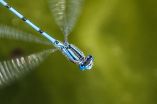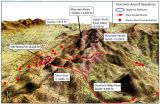(Press-News.org) EUGENE, Ore. -- Women living where rates of infectious disease are high, according to theory, prefer men with faces that shout testosterone when choosing a mate. However, an international study says not so much, says University of Oregon anthropologist Lawrence S. Sugiyama.
The new study, on which Sugiyama is one of 22 co-authors, ended with that theory crumbling amid patterns too subtle to detect when tested with 962 adults drawn from 12 populations living in various economic systems in 10 nations.
The study -- coordinated by Ian S. Penton-Voak of the School of Experimental Biology at the University of Bristol in the United Kingdom -- appears online ahead of print this week in the Early Edition of the Proceedings of the National Academy of Sciences.
"It's not the case that women have a universal preference for high testosterone faces, and it's not the case that such a preference is greater in a high-pathogen environment," Sugiyama said. "And the opposite is also the case. Men don't uniformly appear to have a preference for more feminine faces, at least within the ranges of cultures shown in this study. In cultures tied to pastoralism, agriculture, foraging, fishing and horticulture, not so much, the authors concluded.
The closest the theory came to confirmation was in market economies in the study populations in the U.K., Canada and China, perhaps because, as Sugiyama's prior work has shown, preferences shift in response to the local range of variation in traits, and men in market economies have higher testosterone.
Also, Sugiyama said: "In large-scale societies like ours we encounter many unfamiliar people, so using appearance to infer personality traits can help cope with the overwhelming amount of social information. For instance, in all cultures tested, high testosterone faces were judged to be more aggressive, and this is useful information when encountering strangers."
Sugiyama and three other UO co-authors contributed to the study based on their work with the Shuar, a rural population with a long history of warfare in Ecuador and whose mixed economy today is based on horticulture, hunting, foraging and small-scale agro-pastoralism.
The Shuar did not come into contact with the outside world until the 1880s, and only since the 1960s have they organized into communities, Sugiyama said. The UO's research there is looking at the impacts of culture change on Shuar health. Data for the PNAS study were collected during routine sessions with 30 males and 31 females.
Each was shown culturally appropriate facial representations of potential opposite-sex mates and asked which one they'd prefer. Shuar women didn't like the faces of men whose faces suggested high testosterone levels. "Shuar women preferred slightly less testosterone-looking faces," Sugiyama said. The reason why was not clear, but he suggests that maybe Shuar women possibly have grown weary of years of warfare and would prefer mates who would be less likely to participate and encourage their offspring to engage in violent behaviors.
UO co-authors are J. Josh Snodgrass, a professor of biological anthropology, doctoral student Melissa A. Liebert, who has spent seven research seasons with the Shuar, and undergraduate student Ruby Fried, who has since earned a bachelor's degree from the UO and now is a doctoral student in anthropology at Northwestern University in Evanston, Illinois.
As with the UO team, the paper's other researchers contributed with data collected from the populations that they study. The study encompassed students and Cree populations in Canada, students and urban residents in two Chinese cities, the Tuvans in Russia, students in the United Kingdom, the Kadazan-Dusun in Malaysia, villagers in Fiji, the Miskitu in Nicaragua, the Tchimba in Namibia and the Aka in the Central African Republic.
"Performance by the different populations wasn't chance," Sugiyama said. "For each society there was a pattern. There were significant preferences in each culture. Market economies do play a part, but something more was going on.
"I think the real message of this study is that we in this field need to stop and rethink how we have been thinking about these things," he said. "Maybe the idea of infectious disease -- the presence of pathogens -- isn't the main driving factor. The underlying adaptations are likely to track other ecological considerations and local cultural factors that we don't have data on and may eventually be very important in understanding attractiveness."
INFORMATION:
Co-authors with Penton-Voak, Sugiyama, Snodgrass, Fried and Liebert are: Isabel M. Scott and Andrew P. Clark of Brunel University in the U.K.; Steven C. Josephson of the University of Utah; Adam Boyette and Barry Hewlett of Washington State University; Innes C. Cuthill and Mhairi Gibson of the University of Bristol; Mark Jamieson of the University of East London; William Jankowiak of the University of Nevada, Las Vegas; P. Lynne Honey of Grant MacEwan University, Edmonton, Canada; Zejun Huang and Yangke Zhao of Zhejiang University, Hangzhou, China; Benjamin G. Purzycki, John Shaver and Richard Sosis of the University of Connecticut, Storrs; Viren Swami of the University of Westminster, London, U.K.; and Douglas W. Yu, who is affiliated with both the University of East Anglia, Norwich, U.K., and the Kunming Institute of Zoology in Kunming, China.
The U.K.-based Leverhulme Trust supported the research through a grant to Penton-Voak.
Source: Lawrence Sugiyama, associate professor of anthropology, 541-346-5142, sugiyama@uoregon.edu
Note: The University of Oregon is equipped with an on-campus television studio with a point-of-origin Vyvx connection, which provides broadcast-quality video to networks worldwide via fiber optic network. In addition, there is video access to satellite uplink, and audio access to an ISDN codec for broadcast-quality radio interviews.
Links:
The study: http://www.pnas.org/content/early/2014/09/19/1409643111
Sugiyama faculty page: http://pages.uoregon.edu/sugiyama/
UO Department of Anthropology: http://pages.uoregon.edu/anthro/
Facial masculinity not always a telling factor in mate selection
University of Oregon anthropologists are part of study that throws cold water on theory that infectious disease rates drive such choices
2014-09-23
ELSE PRESS RELEASES FROM THIS DATE:
The mechanics of tissue growth
2014-09-23
PITTSBURGH – When the body forms new tissues during the healing process, cells must be able to communicate with each other. For years, scientists believed this communication happened primarily through chemical signaling. Now researchers at Carnegie Mellon University and the University of Pittsburgh have found that another dimension – mechanical communication – is equally if not more crucial. The findings, published in this week's issue of the Proceedings of the National Academy of Sciences, could lead to advancements in treatments for birth defects and therapies for cancer ...
Insects' fear limits boost from climate change, Dartmouth study shows
2014-09-23
Scientists often measure the effects of temperature on insects to predict how climate change will affect their distribution and abundance, but a Dartmouth study shows for the first time that insects' fear of their predators, in addition to temperature, ultimately limits how fast they grow.
"In other words, it's less about temperature and more about the overall environmental conditions that shape the growth, survival and distribution of insects." says the study's lead author Lauren Culler, an Arctic postdoctoral researcher at Dartmouth.
The study appears in the journal ...
Kessler Foundation researchers find foot drop stimulator beneficial in stroke rehab
2014-09-23
West Orange, NJ. September 23, 2014. Kessler Foundation scientists have published a study showing that use of a foot drop stimulator during a task-specific movement for 4 weeks can retrain the neuromuscular system. This finding indicates that applying the foot drop stimulator as rehabilitation intervention may facilitate recovery from this common complication of stroke. "EMG of the tibialis anterior demonstrates a training effect after utilization of a foot drop stimulator," was published online ahead of print on July 2 by NeuroRehabilitation (doi:10.3233/NRE-141126). The ...
'Brain Breaks' increase activity, educational performance in elementary schools
2014-09-23
CORVALLIS, Ore. – A recent Oregon survey about an exercise DVD that adds short breaks of physical activity into the daily routine of elementary school students found it had a high level of popularity with both students and teachers, and offered clear advantages for overly sedentary educational programs.
Called "Brain Breaks," the DVD was developed and produced by the Healthy Youth Program of the Linus Pauling Institute at Oregon State University, and is available nationally.
Brain Breaks leads children in 5-7 minute segments of physical activity, demonstrated by OSU ...
Surveys may assess language more than attitudes, says study involving CU-Boulder
2014-09-23
Scientists who study patterns in survey results might be dealing with data on language rather than what they're really after -- attitudes -- according to an international study involving the University of Colorado Boulder.
The study, published in the journal PLOS ONE, found that people naturally responded to surveys by selecting answer options that were similar in language to each other as they navigated from one question to another, even when the similarities were subtle.
For the study, researchers looked specifically at surveys on organizational behavior, such as ...
Researchers reveal new rock formation in Colorado
2014-09-23
Boulder, Colo., USA - An astonishing new rock formation has been revealed in the Colorado Rockies, and it exists in a deeply perplexing relationship with older rocks. Named the Tava sandstone, this sedimentary rock forms intrusions within the ancient granites and gneisses that form the backbone of the Front Range. The relationship is fascinating because it is backward: ordinarily, it is igneous rocks such as granite that would that intrude into sedimentary rocks.
According to authors Christine Smith Siddoway and George E. Gehrels, to find sandstone injected into granite ...
Note to young men: Fat doesn't pay
2014-09-23
Men who are already obese as teenagers could grow up to earn up to 18 percent less than their peers of normal weight. So says Petter Lundborg of Lund University, Paul Nystedt of Jönköping University and Dan-olof Rooth of Linneas University and Lund University, all in Sweden. The team compared extensive information from Sweden, the United Kingdom and the United States, and the results are published in Springer's journal Demography.
The researchers analyzed large-scale data of 145,193 Swedish-born brothers who enlisted in the Swedish National Service for mandatory military ...
Immune system is key ally in cyberwar against cancer
2014-09-23
Research by Rice University scientists who are fighting a cyberwar against cancer finds that the immune system may be a clinician's most powerful ally.
"Recent research has found that cancer is already adept at using cyberwarfare against the immune system, and we studied the interplay between cancer and the immune system to see how we might turn the tables on cancer," said Rice University's Eshel Ben-Jacob, co-author of a new study this week in the Early Edition of the Proceedings of the National Academy of Sciences.
Ben-Jacob and colleagues at Rice's Center for Theoretical ...
UTSA microbiologists discover regulatory thermometer that controls cholera
2014-09-23
Karl Klose, professor of biology and a researcher in UTSA's South Texas Center for Emerging Infectious Diseases, has teamed up with researchers at Ruhr University in Bochum, Germany to understand how humans get infected with cholera, Their findings were released this week in an article published by the Proceedings of the National Academy of Sciences.
Cholera is an acute infection caused by ingestion of food or water that is contaminated with the bacterium Vibrio cholerae. An estimated three to five million cases are reported annually and 100,000-120,000 people die from ...
'Space bubbles' may have aided enemy in fatal Afghan battle
2014-09-23
WASHINGTON, DC—In the early morning hours of March 4, 2002, military officers in Bagram, Afghanistan desperately radioed a Chinook helicopter headed for the snowcapped peak of Takur Ghar. On board were 21 men, deployed to rescue a team of Navy SEALS pinned down on the ridge dividing the Upper and Lower Shahikot valley. The message was urgent: Do not land on the peak. The mountaintop was under enemy control.
The rescue team never got the message. Just after daybreak, the Chinook crash-landed on the peak under heavy enemy fire and three men were killed in the ensuing firefight.
A ...
LAST 30 PRESS RELEASES:
MD Anderson and RUSH unveil RUSH MD Anderson Cancer Center
Tomography-based digital twins of Nd-Fe-b magnets
People with rare longevity mutation may also be protected from cardiovascular disease
Mobile device location data is already used by private companies, so why not for studying human-wildlife interactions, scientists ask
Test reveals mice think like babies
From disorder to order: flocking birds and “spinning” particles
Cardiovascular risk associated with social determinants of health at individual and area levels
Experimental NIH malaria monoclonal antibody protective in Malian children
Energy trades could help resolve Nile conflict
Homelessness a major issue for many patients in the emergency department
Undocumented Latinx patients got COVID-19 vaccine at same rate as US citizens
ETRI develops an automated benchmark for labguage-based task planners
Revolutionizing memory technology: multiferroic nanodots for low-power magnetic storage
Researchers propose groundbreaking framework for future network systems
New favorite—smart electric wheel drive tractor: realizes efficient drive with ingenious structure and intelligent control
Using stem cell-derived heart muscle cells to advance heart regenerative therapy
Damon Runyon Cancer Research Foundation awards Quantitative Biology Fellowships to four cutting-edge scientists
Climb stairs to live longer
Scientists capture X-rays from upward positive lightning
AMS Science Preview: Hawaiian climates; chronic pain; lightning-caused wildfires
Researchers advance detection of gravitational waves to study collisions of neutron stars and black holes
Automated machine learning robot unlocks new potential for genetics research
University of Toronto scientists appointed as GSK chairs will advance drug delivery research and vaccine education tools for healthcare professionals
Air pollution and depression linked with heart disease deaths in middle-aged adults
More efficient molecular motor widens potential applications
Robotic nerve ‘cuffs’ could help treat a range of neurological conditions
Researchers identify targets in the brain to modulate heart rate and treat depressive disorders
Findings of large-scale study on 572 Asian families supports gene-directed management of BRCA1 and BRCA2 gene carriers in Singapore
Many children with symptoms of brain injuries and concussions are missing out on vital checks, national US study finds
Genetic hope in fight against devastating wheat disease
[Press-News.org] Facial masculinity not always a telling factor in mate selectionUniversity of Oregon anthropologists are part of study that throws cold water on theory that infectious disease rates drive such choices





